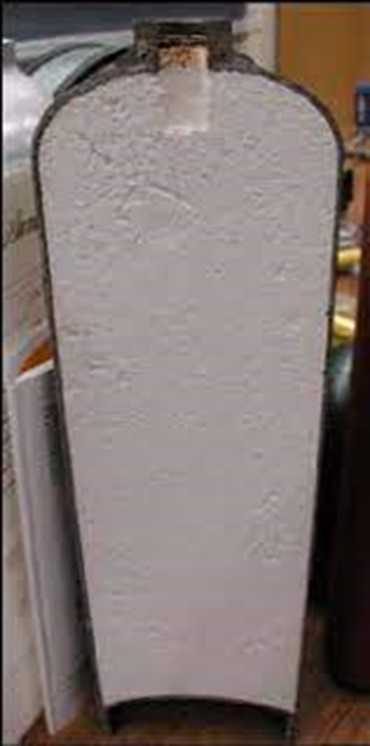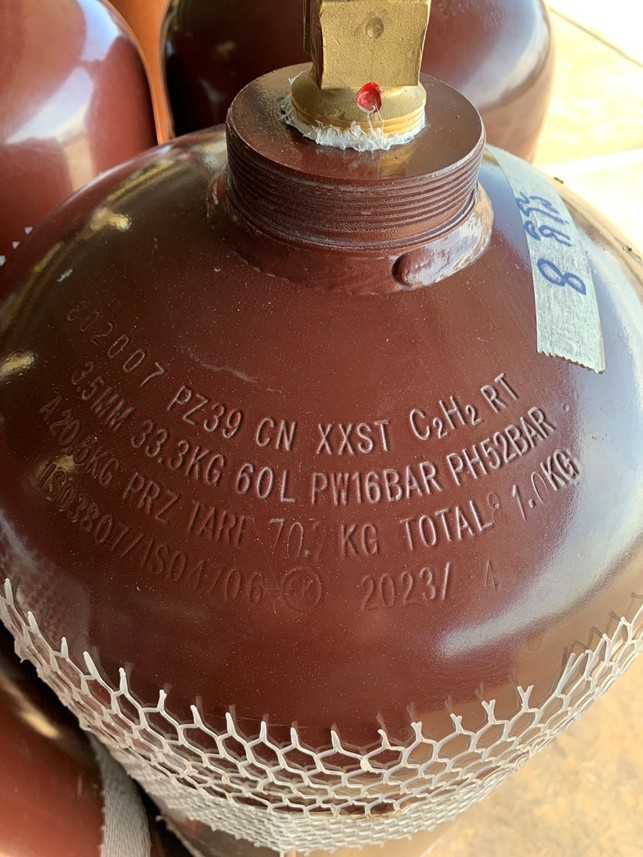Acetylene
Highly Flammable and Explosive
Acetylene, a hydrocarbon with the chemical formula C2H2 , is a chemically unstable gas that can decompose violently when compressed or overheated. To enhance its chemical stability, acetylene is typically dissolved in a liquid solvent such as acetone or DMF within specially designed cylinders. These cylinders are filled with a porous material, enabling the storage and transportation of acetylene at moderate pressure without the risk of decomposition. This innovative approach reduces the hazards associated with filling, transportation, and utilization of acetylene.
| Physical and Chemical Data | |
|---|---|
Molecular weight | 26.038 |
Boiling point | -75°C (at 124 kPa) |
Melting point | -82°C (at 17.8 PSIA) |
Specific volume | 0.903 m3/kg (at 15°C, 101.3 kPa) |
Flammable limits in air | 2.5-5.0% (by volume) |
Autoignition temperature | 305°C |
Solubility in water | 0.3g/100ml in H2O |
Appearance | Colorless, ethereal odor |
Materials to avoid | Unalloyed copper, silver, mercury |
A Product of the Reaction of Calcium Carbide and Water
Acetylene, primarily generated through the reaction of calcium carbide with water, undergoes a purifier process to eliminate moisture and impurities like ammonia, phosphine, and hydrogen sulfide, ensuring its purity. Alternatively, acetylene gas can be produced as a byproduct in certain petrochemical plants, wherein hydrocarbons such as methane or ethane are partially combusted or pyrolyzed at high temperatures. The resulting gas mixture contains small amounts of acetylene, which can be separated and purified through various methods, referred to as chemical acetylene. However, disruptions in the supply of chemical acetylene may occur during petrochemical plant maintenance. Despite this, the calcium carbide process remains the most reliable and cost-effective means of commercial acetylene production.
Unlike other gases like oxygen, acetylene cannot be compressed into cylinders. Acetylene cylinders do not store compressed or liquefied acetylene; rather, they house acetylene gas dissolved in solvents that are absorbed by a porous mass made from silica or fiberglass within the cylinder. These highly absorbent porous masses are filled with a solvent, commonly acetone or dimethylformamide (DMF), into which acetylene gas is dissolved.

Image: The interior of an acetylene cylinder contains numerous porous materials.
The most commonly used solvent for acetylene is acetone, which finds application in both individual cylinders and cylinder packs. However, acetone has a tendency to react with acetylene gas, leading to oxidation in the workpiece and resulting in performance issues. On the other hand, dimethylformamide (DMF) is predominantly utilized in cylinder packs, especially for high-purity acetylene applications. Acetylene dissolved in DMF is considered free from solvent contamination, allowing for higher withdrawal rates. It is crucial to never mix acetone and DMF in an acetylene cylinder, as it would become impossible to determine the residual gas content or solvent loss. In the event of accidental mixing, the cylinder should either be discarded or returned to the cylinder manufacturer for reconditioning.
How Much Acetylene is in an Acetylene Cylinder?
The most accurate method to determine the quantity of acetylene in a cylinder is through weighing it. The weight of acetylene present in the cylinder can be calculated by subtracting the tare weight of the cylinder from the gross weight, providing the net weight of the acetylene. The tare weight encompasses the weight of the empty cylinder, the valve, the mass of the cylinder itself, and the solvent it contains.

Image: The label showing tare weight of an acetylene cylinder.
Nominal Pressure Bar for Acetylene at Different Ambient Temperature
Using a pressure gauge regulator is not a viable method to determine the quantity of acetylene gas within an acetylene cylinder. The pressure indicated on the regulator is solely a result of the acetylene released from the solvent and does not represent the total amount of acetylene in the cylinder. In fact, a higher amount of dissolved acetylene is preferable for safety reasons. It's important to note that the pressure within an acetylene cylinder is influenced by the cylinder's temperature, not by the quantity of acetylene it contains.
| Temperature (°C) | Pressure Bar with Acetone Solvent | Pressure Bar with DMF Solvent |
|---|---|---|
| 40° | 21 | 23 |
| 30° | 19 | 21 |
| 20° | 15 | 17 |
Acetylene Use in a Variety of Industrial Applications
Acetylene is used in a variety of industrial applications, including
- welding
- metal cutting
- fuel in heat treatment process
- chemical synthesis
Known for its exceptional efficiency among fuel gases, it offers heightened productivity as it demands the least amount of oxygen for complete combustion. Its minimal flame moisture content renders it an excellent option for numerous crucial industrial heating processes. Moreover, acetylene stands out as the sole recommended fuel gas for underground working conditions due to its lighter-than-air properties.
In cutting, oxy-acetylene flame gives the fastest pre-heating piercing times than any other fuel gas combination. Some of the major benefits of using the oxy-Acetylene flame are:
- improved cut quality
- higher cutting speeds
- fastest cut initiation time
- reduced oxygen use
Acetylene is also the only fuel gas that can weld steel.
Safety Information
Health Hazard Data
- When inhale, one may experience dizziness and drowsiness. Breathing difficulties such as suffocation and asphyxiation may arise if overexposured. In some cases this might lead to loss of consciousness and death. Medical treatment and admission to hospital also be needed upon circumstances.
- Symptoms : rapid and gasping respiration, rapid fatigue, nausea and vomiting.
First Aid
- Before entering area, make sure to be self protected by breathing equipment.
- Immediately remove victim to a well ventilated and spatial area.
- In case of asphyxia, move patient to open air. If breathing has stopped, give artificial respiration immediately.
- In case of thermal burns, immerse affected area in cold water for 10 to 15 minutes. Bandage lightly with sterile dressing.
- Call ambulance for further medical treatment and observation.
Precaution and Safety Measures
- Store away from oxidizing sources in a well-ventilated area.
- No smoking or naked flame within a specified area.
- Securely close cylinder valve when not in use.
- Regularly perform leak checking for possible leakage.
- Do not reticulate at pressure greater than 100kPa.
- Use only approved equipment.
- Move and store cylinders correctly.
- Never attempt to repair a leaking or damaged cylinder valve.
When Leakage is Observed, Please Follow the Instructions Below
- Shut off engines, electrical equipment and other sources of ignition.
- Avoid making any sparks or light.
- If possible and safe, locate and stop leak.
- If not, move cylinder to a roomy area outdoor and allow to empty.
- Evacuate people from the area.
- Call emergency services if necessary.
In Case of Fire
- Evacuate people from the area.
- Cut off source of gas if it is able and safe to do so.
- Cool cylinders with water from a protected location.
- Do not approach cylinders suspected to be hot.
- Call emergency services if necessary.
Special Instructions
- Regularly check for leakage by dropping soapy water on cylinder valve. High pressure leaks can usually be heard. If cylinder is leaking, remove to well ventilated area and inform manufacturer.
- Since acetylene is a highly flammable gas, handling, storing and using of it should be done with maximum care. Fail to do so may result in injure or fatality.
Jirut Industrial Co., Ltd. © 2023 - 2025.